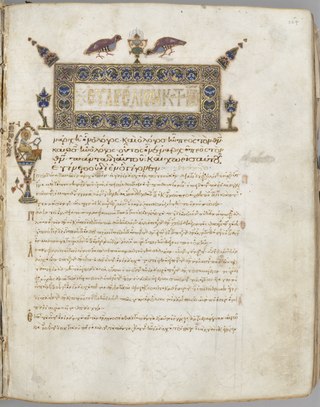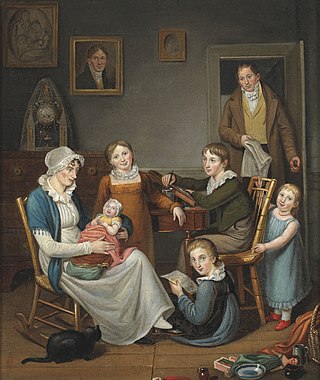Related Research Articles

An illuminated manuscript is a formally prepared document where the text is decorated with flourishes such as borders and miniature illustrations. Illuminated manuscripts include liturgical books such as psalters, courtly literature, and documents such as proclamations.

The Vienna Genesis, designated by siglum L (Ralphs), is an illuminated manuscript, probably produced in Syria in the first half of the 6th century. It is the oldest well-preserved, surviving, illustrated biblical codex.

The Morgan Bible, also called the Morgan Picture Bible, Crusader Bible, Shah Abbas Bible or Maciejowski Bible, is a unique medieval illuminated manuscript. It is a picture book Bible consisting of 46 surviving folios. The book consists of miniature paintings of events from the Hebrew Bible, set in the scenery and costumes of thirteenth-century France, and depicted from a Christian perspective. It is not a complete Bible, as it consists largely of illustrations of stories of kings, especially King David. The illustrations are now surrounded by text in three scripts and five languages: Latin, Persian, Arabic, Judeo-Persian, and Hebrew. The level of detail in the images and the remarkable state of preservation of the work make it particularly valuable to scholars.

Julius Schnorr von Carolsfeld was a German painter, chiefly of Biblical subjects. As a young man he associated with the painters of the Nazarene movement who revived the florid Renaissance style in religious art. He is remembered for his extensive Picture Bible, and his designs for stained glass windows in cathedrals.

Europeans in the 16th century divided the world into four continents: Africa, America, Asia, and Europe. Each of the four continents was seen to represent its quadrant of the world—Africa in the south, America in the west, Asia in the east, and Europe in the north. This division fit the Renaissance sensibilities of the time, which also divided the world into four seasons, four classical elements, four cardinal directions, four classical virtues, etc.

Fraktur is a highly artistic and elaborate illuminated folk art created by the Pennsylvania Dutch, named after the Fraktur script associated with it. Most Fraktur were created between 1740 and 1860.

John Lewis Krimmel, sometimes called "the American Hogarth," was America's first painter of genre scenes. Born in Germany, he immigrated to Philadelphia in 1809 and soon became a member of the Pennsylvania Academy of the Fine Arts. Initially influenced by Scotland's David Wilkie, England's William Hogarth, and America's Benjamin West, he soon turned to direct observation of life for his genre scenes.

The Bible moralisée, also known as the "Bible Historiée", the "Bible Allégorisée" and sometimes "Emblémes Bibliques", is a later name for the most important examples of the medieval picture bibles, called in general "biblia pauperum", to have survived. They are heavily illustrated, and extremely expensive, illuminated manuscripts of the thirteenth century, and from the copies that still survive it is clear that they existed in at least two versions with different contents. They were similar in the choice and order of the Biblical texts selected, but differed in the allegorical and moral deductions drawn from these passages.

The Rochester Bestiary is a richly illuminated manuscript copy of a medieval bestiary, a book describing the appearance and habits of a large number of familiar and exotic animals, both real and legendary. The animals' characteristics are frequently allegorised, with the addition of a Christian moral.

The Wenceslas Bible or the Bible of Wenceslaus IV is a multi-volume illuminated biblical manuscript written in the German language. The manuscript was commissioned by the King Wenceslaus IV of Bohemia and made in Prague in the 1390s. The Wenceslas Bible is unique and very precious not only because of its text, which is one of the earliest German translations of the Bible, but also because of its splendid illuminations. This oldest German deluxe Bible manuscript remained uncompleted.

The Birds' Head Haggadah is the oldest surviving illuminated Ashkenazi Passover Haggadah. The manuscript, produced in the Upper Rhine region of Southern Germany in the early 14th century, contains the full Hebrew text of the Haggadah, a ritual text recounting the story of Passover – the liberation of the Israelites from slavery in ancient Egypt – which is recited by participants at a Passover Seder. The text is executed in block calligraphy and accompanied by colorful illustrations of Jews performing the Seder practices and reenacting Jewish historical events. The Birds' Head Haggadah is so called because all Jewish men, women, and children depicted in the manuscript have human bodies with the faces and beaks of birds. Non-Jewish and non-human faces are blank or blurred. Numerous theories have been advanced to explain the unusual iconography, usually tied to Jewish aniconism. The Haggadah is in the possession of the Israel Museum in Jerusalem, where it is on permanent exhibition.
Francis Charles Portzline was an American fraktur artist of German birth.
Johannes ErnstSpangenberg (1755–1814) was an American fraktur artist.
Samuel Bentz (1792–1850) was an American fraktur artist.
George Heinrich Engellhard was an American fraktur artist. His name is sometimes given as George Hennerich Engelhard.

Johann Adam Eyer (1755–1837) was an American fraktur artist.
Johann Conrad Gilbert (1734–1812) was an American fraktur artist.

The Sussel-Washington Artist was an American fraktur artist active during the 1770s and 1780s.

The Golden Haggadah is an illuminated Hebrew manuscript originating around c. 1320–1330 in Catalonia. It is an example of an Illustrated Haggadah, a religious text for Jewish Passover. It contains many lavish illustrations in the High Gothic style with Italianate influence, and is perhaps one of the most distinguished illustrated manuscripts created in Spain. The Golden Haggadah is now in the British Library and can be fully viewed as part of their Digitized Manuscript Collection MS 27210.
Don Yoder was an American folklorist specializing in the study of Pennsylvania Dutch, Quaker, and Amish and other Anabaptist folklife in Pennsylvania who wrote at least 15 books on these subjects. A professor emeritus at the University of Pennsylvania, he specialized in religious folklife and the study of belief. He is known for his teaching, collecting, field trips, recording, lectures, and books. He also co-founded a folk festival in Pennsylvania, which is the USA's oldest continual annual folklife festival, and is credited with "bringing the idea of "folklife" to the United States".
References
- 1 2 3 4 Gerard C. Wertkin (2 August 2004). Encyclopedia of American Folk Art . Routledge. ISBN 978-1-135-95614-1.
- ↑ Sandra Sider (1997). Bibliography of Emblematic Manuscripts. McGill-Queen's Press - MQUP. pp. 48–. ISBN 978-0-7735-1550-5.
- ↑ "The picture bible of Ludwig Denig". Aug 14, 2015. Retrieved Apr 11, 2019.
- ↑ Denig, Ludwig (Apr 11, 1990). "The Picture-Bible of Ludwig Denig: A Pennsylvania German Emblem Book". Hudson Hills Press in association with the Museum of American Folk Art and the Pennsylvania German Society. Retrieved Apr 11, 2019.
- ↑ Delamaire, Marie-Stéphanie & Joan Irving, "The Denig Manuscript Project: Art Making in the Early American Borderlands" Winterthur website, n.d.; accessed April 6, 2023